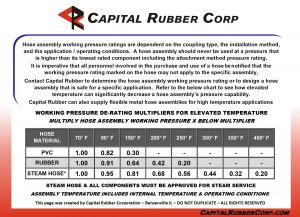
When a hose will be installed where the application involves elevated temperature, it is important to check the working pressure rating of the hose at that temperature. The listed working pressure on a hose is based on normal operating conditions and temperature (65 – 75 degrees F). Because rubber and plastics become softer at the high end of their temperature range, the pressure rating of the hose assembly is affected inversely when heat is increased. The chart linked on this page lists multipliers for different operating temperatures.
To find the safe operating pressure of a hose follow these steps:
- Verify the pressure and temperature range recommended for the hose series. If the hose is assembled, consult the assembler or seller to determine the working pressure of the assembly, which must take into account the pressure rating of the couplings and all components, and the means of attachment (clamp, ferrule, etc) be sure to include any gasket within the hose coupling.
- Next, determine the operating temperature of the application. Be sure to consider both the internal temperature and external environment (use the higher of the two).
- Referring to the chart, find the multiplier for rubber, plastic, or steam hose, for the operating temperature determined in step 2.
- Multiply the standard pressure rating from step 1 by the multiplier found in step 2 to determine the safe pressure rating of the hose assembly. This is your safe working pressure at that temperature. If the hose is branded with a higher working pressure, it should be tagged with a warning and all potential operators should be made aware of the temperature-corrected pressure rating.
Example: A rubber hose marked 150 PSI and assembled to meet the 150 PSI rating, that is operating at 150 degrees F (multiplier 0.64) will have a safe working pressure of 96 PSI.

Leave a Reply
You must be logged in to post a comment.